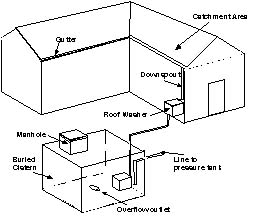By Mike Mecke
For thousands of years, the world has relied upon rainwater harvesting to supply water for household, landscape and agricultural uses.

How to harvest rainwater
Before city water systems were developed, rainwater was collected (mostly from roofs) and stored in cisterns or storage tanks. Rainwater is a free source of nearly pure water and too valuable to waste.
Many parts of the world, including Hawaii and Australia, use rainwater as the main source of household water. On many Carribbean islands where rain is the most viable supply, public buildings, homes and resorts all collect rainwater for their needs. Hong Kong collects rainwater from sky scrapers!
In South Texas, the central plazas of towns were not only gathering places, but also the collection surfaces for underground tanks where water was stored for use by adjacent shops and homes. Take a look at the old metal cistern at the Grey Mule Saloon in Fort Stockton. Wouldn’t be hard to put something like that at your place, would it? These systems may no longer be in use, but they are clear evidence of the reliance placed on rainwater by early Texans.
Unfortunately, as Texans bought windmills or REA provided electric power for wells, the earlier home rainwater harvesting systems were dismantled or forgotten by younger generations.
Today, many Texans are becoming interested again in rainwater harvesting sometimes out of necessity due to overstressed aquifers and drought-plagued surface water supplies.
Several cities in Texas have begun programs to educate the public on RWH. The Lady Bird Johnson Wildflower Research Center near Austin has a large system used for inside potable uses and to irrigate research plots and grounds.

Rainwater Cistern
RWH can be used to supply potable (drinkable) water. For potable uses, rainwater must be treated to remove or kill disease organisms that may be present.
For non-potable uses, like watering landscapes or home gardens and orchards, it is ready for use as it falls from the sky.
For livestock, larger systems can be designed to provide supplemental water in a pasture or in some instances, all of the water required by stock. In Arizona and many of the Western and Rocky Mountain states, RWH systems for livestock are in use on Indian reservations and Forest Service or Bureau of Land Management rangelands where groundwater is either too deep for windmills or non-existent and surface water is either rare or of poor quality.
Many years ago, I was range manager on the Papago Reservation in southern Arizona, and we watered entire cattle herds from rainwater catchments of an acre or two in size, storing water in large concrete tanks with troughs.
For wildlife, small systems called wildlife guzzlers can be constructed to promote quail and other wildlife species in water-short areas. Texas Parks & Wildlife Department has many across West Texas they work! See one at the Chihuahuan Desert Research Center near Fort Davis, and see two landscape catchment systems for landscape irrigation.
Why use rainwater?
1.Rainwater harvesting promotes self-sufficiency and an appreciation for water resources.
2.Promotes water conservation, providing a new water resource.
3.Rainwater harvesting saves energy requiring only a small pump or gravity flow.
4.Rainwater is one of the purest sources of water.
5.Rainwater often has a nitrogen content which provides a slight fertilizing effect.
6.Rainwater is soft water for your home. A few commercial rain barrels and a hose will work. Or clean 55 gallon drums will also do.
Your local county Cooperative Extension offices are planning demo sites in Alpine, Sanderson, Van Horn and Sierra Blanca and will assist you. Check the Web site at: https://www.twdb.state.tx.us/assistance/conservation/Alternative_technologies/RainwaterHarvesting/Rain.asp.
Mike Mecke is a water resources specialist at the Texas Cooperative Extension Center in Fort Stockton.
3 Responses
Sir,
We in this part of India have taken up rain water harvesting seriousley.
Lot of innovations are being introduced by village flocks even.
Sir, could you please include my URL under Solar cooker list ?
Thank you,
ashok
The link is almost right, its:
https://www.twdb.state.tx.us/assistance/conservation/Alternative_Technologies/Rainwater_Harvesting/Rain.asp